Going fossil-free in a terraced Victorian house
When our 14-year-old Worcester combi-boiler broke at the start of 2019, we anticipated going through all the motions of getting a new one. Quotes from local plumbers for repair or replacement. Repair quotes came with not much reassurance about how long the repairs would actually last and replacement seemed to be the more sensible longer-term solution. A new boiler could come with a ten-year guarantee.
But wait a minute, ten years?! That means it'll be 2029 at the earliest when it'll be replaced. Are we not meant to be stopping our use of gas in order to reach net-zero CO₂ emissions? Why am I filling out these anti-fracking petitions online?
Getting a new gas boiler in the year 2019 seemed to make no sense at all with the ongoing, painfully obvious climate disaster unfolding before our eyes on a daily basis.
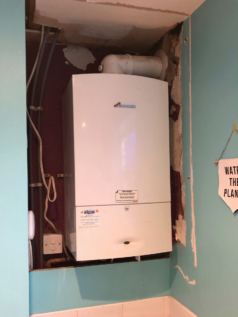
A common kitchen sight, our old Worcester Greenstar 30si.
Thankfully for us our boiler somehow magically limped on for the next few months, allowing us to look at the alternatives. I'd previously been interested in Micro-CHP boilers, which use gas really efficiently and also generate electricity whenever the gas is being burnt. But there are few options available and, well, it's still gas, still fossil fuels. Another option was the SunAmp heat battery. Basically one of those "snap to activate" hand warmers, but in a huge format, generating hot water and charging from solar energy. These were less of an option without existing solar and I was unable to find a local installer who would quote me for installation. Then I got on to Heat Pumps: available in air, water or ground. Put simply, they extract heat energy from their given source (air, water or the ground) and use it to create hot water. The only viable option for our small terraced garden was an Air Source Heat Pump. They are basically a big box with a fan, they live outside and are plugged into the electricity supply. I started learning a bit about what was required and understanding exactly what a heat pump installation would comprise of: An air source heat pump (or "ASHP"), a hot water tank, some small control boxes and electrics. Heat pumps operate central heating radiators at a lower temperature, so the heat efficiency of your home becomes really important. This was not going to be a problem for us, however, as we've just spent the last 3 years insulating our home with Internal Wall Insulation and our new loft conversion would be to all the latest building standards. It would mean that some of our radiators might need increasing in size, but all of ours were installed since we moved in so this was something we could reassess in the winter. Our outdoor space is only around 5m square, and there was only really one place we could fit the large heat pump unit, but it would fit! We would need somewhere to put the hot water tank, but the outdoor lean-to I'd built, directly opposite the wall where the boiler was, would be a good location for this. The bonus of removing the boiler would also be that we gained a kitchen cupboard, which would be an epic win in our kitchen, which is lacking somewhat in storage. An Air Source Heat Pump was looking like the main alternative option for us, but how much was it all going to cost to install?
I got three quotes from local firms and was amazed at the price variations - all for essentially the same thing: heat pump, cylinder, installation and electrics.
Those numbers were not nice to look at, especially when the quote for a new gas boiler was around £2,700. But then, this is where the Renewable Heat Incentive or "RHI" comes in. Basically, if you install a renewable heating system you will get paid by the government for the energy that you generate which would otherwise be using fossil fuels such as oil or gas. Each quotation will give you an estimate, based on your hot water and central heating usage, of how much your RHI payments will be. We were told we could expect to receive £225 every quarter, making a total of £6,300 over 7 years. And at that point, the third quote starts to make a bit more sense. That brings the total cost down to £2,264. Actually cheaper than the gas boiler quote we'd received! Of course, this is an estimate and only time will tell the actual figure we would receive back. But from the three quotes, two provided an RHI estimate and this one was a more conservative one.
Naomi and I had a long talk together about the realities of making a decision like this and in the end, we decided that we're in a privileged enough position where we could realistically afford to do this. Or at least, we could afford to borrow the upfront cost. As a growing family, we have an obligation to reduce our carbon footprint and this was our chance to commit to that. Some other more frivolous things would have to wait as I dug into savings a little, but - priorities. We spoke with the third company and agreed to move forward with the work. Thankfully, despite having the lowest quote, they were also the most competent, providing ample information in the quote which made it seem like they really knew what they were doing.
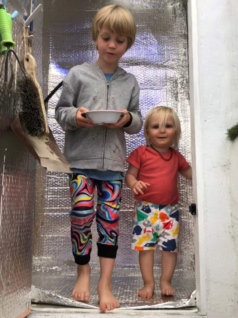
Rocco & Jules hanging out in the space cupboard pre-install.
There was one problem to this grand plan, however - getting the heat pump into the garden. The heat pump is quite big - 100cm x 100cm x 50cm. This meant, due to the recent changes to our stairwell (for the loft conversion fire regs), it would be too big to fit down our stairs. We decided to speak with our neighbours, who were brilliantly helpful in agreeing that we could take it through their house and over the garden wall. There was a bit more risk involved there but we had a plan.
We'd been finishing up our loft conversion when time allowed and the new heating system hadn't seemed particularly urgent. Our boiler, which had been not-so merrily limping along all this time finally conked out and then I had to get some dates booked in. We had two weeks without hot water during June before the work started.
Preparation
I cleared out the area outside where the heat pump was going to go, moving our Hot Bin composter out of the way. The only other thing to do was to clear out and insulate the lean-to, where the 180L cylinder was going. This would help a little bit with the winter months. That didn't take long and the boys enjoyed hanging out in the "sci-fi cupboard" for all of a day.
Inside, I removed the cupboard door and frame that was around the boiler, something I'd only added within the last year, it's always a little frustrating to undo work you've done.
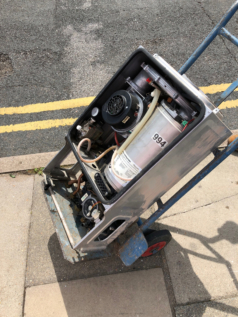
Good riddance!
Installation starts
Two plumbers arrived first thing on a Monday and set about moving in the kit. The boiler came out and was unceremoniously carted off down the road and loaded on to the back of a van. If felt like a moment to celebrate, or perhaps shout "AND STAY OUT!", but was also weirdly terrifying to know that this was definitely all happening.
The EcoDan arrived at midday and was successfully taken via the neighbours garden into ours. That bit was quite nerve-wracking, I am very thankful to our neighbours (although I still need to figure out the longer-term solution). Work continued for two more days, putting in the pipework from the house into the lean-to, and from there to the heat pump unit. The two plumbers worked really well and were very professional.
There was a slight hiccup with the cylinder, the wrong size was delivered initially which added an extra day to the work. So Thursday was a no-go and then Friday, the correct cylinder arrived and a new plumber finished up the work. He temporarily hooked up the immersion heater for hot water over the weekend. Great!
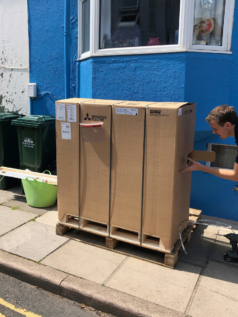
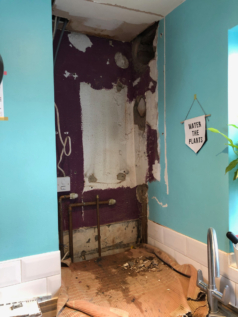
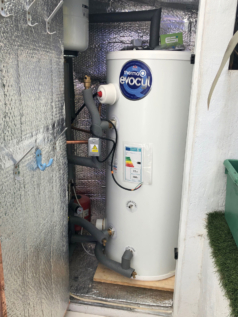
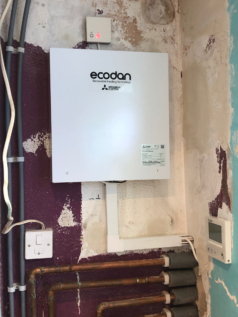
Various stages of the installation.
On the following Monday, the electricians arrived and wired everything, giving the heat pump power and adding the control unit for all the kit, plus a thermostat. They took around half a day and left us with a working heat pump! This was a slightly daunting part as this was the first time I could hear what one sounded like. Well, I needn't have worried as it's really quiet. It's set to come on for two hours twice a day too so it's hardly on much at the moment and I never notice when it is.

And there he is, EcoDan. He is sizeable but rather quiet and you hardly notice him when he's on.
Tying up loose ends
Half-way through installation, I ordered an induction hob to get rid of the gas one. I remember a time when I used to lament flats I'd lived in if they didn't have gas, but now I look at a gas hob and I only see the massive amounts of heat being fired in all directions around a pan - they are insanely inefficient. I read a few reviews and picked up a Bosch induction hob for just under £400. It's great! It heats things up really fast, you can control the temperature immediately, plus it's safe and easy to clean. Our existing saucepans were compatible and it even came with some brand new pans, which it turned out, were surprisingly good quality.
As soon as the installation had been completed, I set about finding out how I can disconnect our gas supply. Partly as a statement, and partly because it doesn't seem very sensible to keep paying a standing charge on something I won't ever use. I soon discovered that there were two things to be done: 1. Disconnect the incoming supply, which needs to be done by the gas supplier in the area; and 2. Once the incoming supply had been capped, disconnect the meter - this was something that could be done by my energy provider. Well, I was told by the gas supplier that I could expect to pay between £800 - £1000 to disconnect and then after that, it would cost £130 to remove the meter. This was a bit of a shock. If we really do need to stop using gas and are to be converting a million homes a year to low-carbon by 2025, how is this going to remain at all sensible? The lady from the gas supply company chirpily informed me that leaving a gas supply connected to the home can be appealing to future buyers... at that point, it's clear we're not really thinking along the same lines here. So, we're left with around £75 a year standing charge to pay on our gas. This doesn't quite seem right, but it's the better option for us at the moment.
Living with the heat pump
We've had it installed for 10 days so far and I've only ever seen it running on the first day it was installed. There's hot water day in, day out and the big EcoDan is sat there pretty much all the time, static, silent and motionless. I'm sure once the weather starts cooling down that will change, but for now, it genuinely does all seem a bit magic. Hot water from thin air.
There are still a few things left to do. We're waiting for our sign-off visit from the installation company. Incidentally, that company is BSW and I would thoroughly recommend them. This will help get us registered with the RHI payment scheme and get a rundown of the control setup. I've also got to install a new kitchen cupboard to house the wall unit and tidy up that corner of the kitchen.
So far, our bath, two showers and general washing up seem to be using around 2.4kWh a day. I'm planning on keeping track of usage over time so we can get an idea of the cost difference over gas. I'm expecting it to be about the same, but we will see over time (obviously our electricity supply is 100% renewable!). There's a lot to this which felt like you just needed to take the leap, and the finer details would become clear later.
It's a good feeling stopping our use of gas, it feels like as a household we've managed to achieve something that perhaps not many people in terraced houses have been able to do yet. I'm hoping that this can help to show people that transition to clean heating and hot water is possible, even when space is limited in these older Victorian properties.
Update: July 2020
We've now had the air source heat pump for a year, and I've compiled a full year's worth of usage and cost data in my next post: One year with an Air-Source Heat Pump: Real-world costs and experience.
Update: October 2021
I spoke about my heat pump installation at the Green Hanover Homes event and you can see me talk it online.